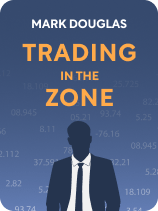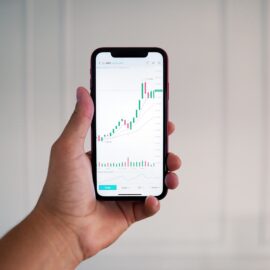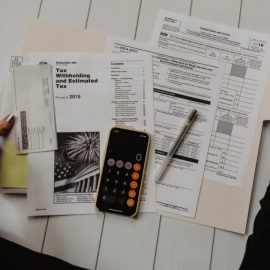

This article is an excerpt from the Shortform book guide to "Trading in the Zone" by Mark Douglas. Shortform has the world's best summaries and analyses of books you should be reading.
Like this article? Sign up for a free trial here .
Do you want to know how to become a successful trader? What do all profitable traders have in common?
Trading is extremely hard, which is why only a few traders become profitable. According to Mark Douglas, the author of Trading in the Zone, you need three ingredients to become a successful trader: 1) a clear goal, focused exclusively on winning consistently, 2) a system of rules and boundaries for making trades, and 3) disciplined follow-through.
Let’s explore each ingredient in detail.
#1: A Clear Goal Focused on Winning Consistently
In his book Trading in the Zone, Mark Doulas explains how to become a successful trader. First, Douglas says you need to decide with absolute certainty that what you desire more than anything else when you trade is to win consistently. You have to desire consistency to such an extent that you abandon all other motivations for trading. Once you commit to this singular goal, you’ll willingly accept any outcome the market delivers without emotional distress or fear. Then, you’ll approach market activity not as a way to avoid pain or prove something but as a means to gain an edge and profit.
Douglas says overcoming fear may be faster and easier for some people. Why? People who’ve experienced childhood traumas may have more persistent fear. Also, people may have beliefs that conflict with accumulating wealth, such as the belief that having more money than others is selfish. Nevertheless, Douglas seems to say that everyone—through focused effort—can shift from negative, disempowering beliefs to optimistic, empowering beliefs that form the foundation of a winning mindset.
Entering the “Zone” to Achieve Easy, Effortless Trading
Further, Douglas says, your ultimate goal as a trader should be to achieve consistent success as an automatic, free-flowing expression of who you are. Then, you can experience trading as easy, effortless, fun, and rewarding.
Douglas explains that you can’t force consistency or achieve it through effort. The very act of trying indicates that you’re resisting or struggling against something, or that you’re emotionally attached to getting something from the market. That inclination, though natural, is self-defeating. It ensures that you’ll continue to make fear-based errors.
(Shortform note: While Douglas says effort hinders consistency, many people offer actionable tips for improving trading consistency, implying that you can improve your consistency through effort. For example, trading experts suggest safeguarding your consistency by working to downplay your “herd instinct,” the impulse to follow the crowd and make trading decisions based on what others are doing. The urge to follow the crowd may seem safe, but this reactionary approach can lead to errant and unprofitable trading decisions, thereby sabotaging consistency. Instead, always make sure you base your trading decisions on a coherent strategy, not popular sentiment.)
However, when you’re simply open to whatever the market offers, you can spontaneously enter the “zone.” Douglas describes the zone as a state of mind in which you feel no fear and act intuitively without hesitating. When you’re in this state, your actions always generate a favorable result—without strain or conscious effort. Although Douglas says you can’t intentionally generate a zone mindset, you can set up the conditions for it to spontaneously emerge.
Trading in the zone, Douglas says, is similar to the experience many athletes describe when they spontaneously enter an inherently creative state while performing. While in that state, they perform with astounding proficiency—with an ease and effortlessness that seems almost impossible. They aren’t “trying,” weighing the consequences of their actions, or feeling any fear about messing up. Rather, they’re performing intuitively and seizing opportunities that present themselves moment by moment.
#2: A System of Rules and Boundaries for Making Trades
Second, Douglas says you need an organized, systematic set of rules for identifying opportunities to buy or sell. You can purchase a system from an expert, or you can define your rules through fundamental and/or technical analysis. Douglas doesn’t make specific recommendations about a system to use, but he says whichever system you choose must have two specifications:
- Precise variables that you use to make objective decisions—The variables will tell you when you should get into the market, get out of the market, take profits, or cut losses.
- A definitive time frame for analysis—Douglas recommends choosing a consistent time frame on which to base all of the variables you use to identify optimal points of entry and exit. This can be any time frame you want—hours, weeks, months, or years: just keep it consistent.
By creating a precise system, Douglas explains, you’ll eliminate any need to make subjective decisions. You’ll also ensure that no extraneous variables interfere in your analysis.
#3: Disciplined Follow-Through
Lastly, Douglas says you need to exercise self-discipline to firmly integrate the beliefs and behaviors that support your goal. You must simultaneously do two things: redirect negative thoughts and emotions, and execute the system you’ve established.
Monitor and Redirect Negative Thoughts
The first part of exercising self-discipline involves closely monitoring your thoughts and emotions. Douglas claims the process of becoming a consistently successful trader is psychological, so you must stay alert to any thought that causes you to doubt your system, yourself, or the market. As we’ve discussed, any time fear surfaces, you become vulnerable to making errors. Therefore, if you detect any fear or negative thoughts, gently redirect your thoughts to the core beliefs that all successful traders internalize, which we’ve already covered:
- Eliminating risk is impossible.
- Each market outcome is unique and random.
- You can never know or control what will happen next.
- You can make money regardless of individual outcomes.
- When you have an edge, every loss brings you closer to a win.
According to Douglas, by routinely redirecting negative thoughts, you can create the mental conditions that allow you to enter the zone. Then, you’ll see market activity as just neutral information, telling you what the odds are for success or failure. In other words, you’ll view the market from a truly objective perspective, seeing it not as a threat but as a source of unlimited opportunities to win and profit. As a result, Douglas says, you won’t be inclined to distort or deny information based on what you’re afraid will happen. Instead, you’ll act without hesitation even in the face of constant uncertainty—with the appropriate amount of restraint.
Execute Over Time
The second part of exercising self-discipline involves perfectly implementing the system you’ve established, resisting any temptation to make adjustments. According to Douglas, by staying disciplined in your thoughts and actions, you’ll accumulate positive experiences that align with your objectives and the beliefs you want, thereby reducing interference from fear, doubt, and negative interpretations of your experiences. Then, you’ll see the market objectively, perceive opportunities clearly, and achieve consistent success. All internal resistance will be gone.
(Shortform note: Can positive experiences offset negative experiences, as Douglas says? Researchers say yes: Studies show that it takes three positive experiences to offset one negative experience. Why do we need more positive experiences to outweigh the effect of a single negative experience? Our brains have a built-in negativity bias that causes us to perceive or overinflate negativity, even when a situation is positive or neutral, and dwell on negative events more than positive ones.)
Thus, if you incur a trading loss, Douglas says your best course of action is to continue trading according to the rules you’ve established in your system (assuming your system is sound). As market activity unfolds, you’re sure to win over the long term due to the probabilistic nature of the market.
Given the dynamic nature of the market, Douglas notes, you’ll likely need to adjust your trading variables and rules at some point. Any edge you define is based only on a single moment in time. As market activity unfolds—and traders come and go—the effectiveness of your system may decline. However, you need to give your current system a chance to work. Remember: You need a large enough sample size for probabilities to play out in your favor.
How many trades are enough to test your variables? Douglas recommends a sample size of at least 20 trades. Then, if needed, you should make adjustments and complete your next 20 trades using the new set of variables. By trading in sample sizes, you’ll be able to accommodate changes while maintaining a steady approach.

———End of Preview———
Like what you just read? Read the rest of the world's best book summary and analysis of Mark Douglas's "Trading in the Zone" at Shortform .
Here's what you'll find in our full Trading in the Zone summary :
- The role mindset plays in stock trading
- The critical importance of embracing risk
- How to become a confident, consistent winner






